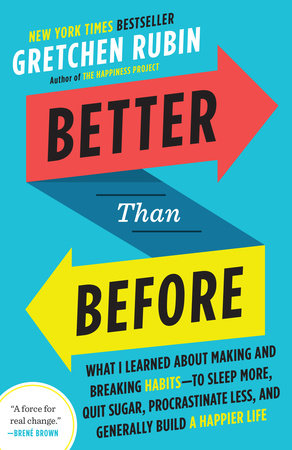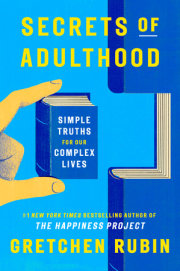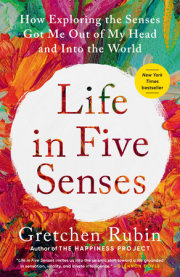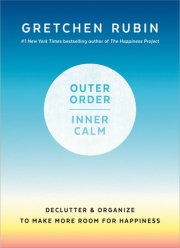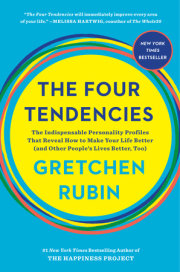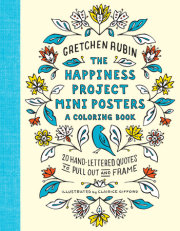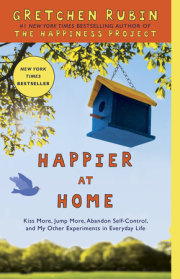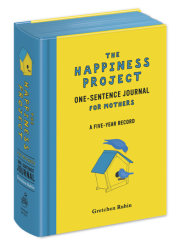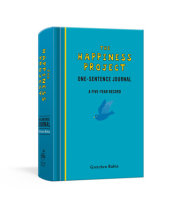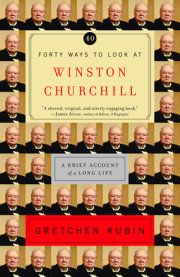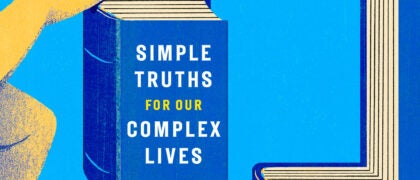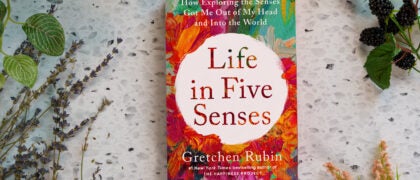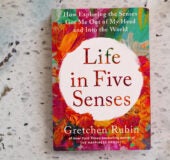A NOTE TO THE READER
Better Than Before tackles the question:
How do we change? One answer—by using habits.
Habits are the invisible architecture of daily life. We repeat about 40 percent of our behavior almost daily, so our habits shape our existence, and our future. If we change our habits, we change our lives.
But that observation just raises another question:
Okay, then, how do we change our habits? That’s what this book seeks to answer.
But while
Better Than Before explores how to change your habits, it won’t tell you what particular habits to form. It won’t tell you to exercise first thing in the morning, or to eat dessert twice a week, or to clear out your office. (Well, actually, there is
one area where I do say what habit I think is best. But only one.)
The fact is, no one-size-fits-all solution exists. It’s easy to dream that if we copy the habits of productive, creative people, we’ll win similar success. But we each must cultivate the habits that work for
us. Some people do better when they start small; others when they start big. Some people need to be held accountable; some defy account- ability. Some thrive when they give themselves an occasional break from their good habits; others when they never break the chain. No wonder habit formation is so hard.
The most important thing is to
know ourselves, and to choose the strategies that work for us.
Before you begin, identify a few habits that you’d like to adopt, or changes you’d like to make. Then, as you read, consider what steps you want to try. You may even want to note today’s date on your book’s flyleaf, so you’ll remember when you began the process of change.
To help you shape your habits, I regularly post suggestions on my blog, and I’ve also created many resources to help you make your life better than before. But I hope that the most compelling inspiration is the book you hold in your hands.
I see habits through the lens of my own experience, so this ac- count is colored by my particular personality and interests. “Well,” you might think, “if everyone forms habits differently, why should I bother to read a book about what someone else did?”
During my study of habits and happiness, I’ve noticed something surprising: I often learn more from one person’s idiosyncratic experiences than I do from scientific studies or philosophical treatises. For this reason,
Better Than Before is packed with individual examples of habit changes. You may not be tempted by Nutella, or travel too much for work, or struggle to keep a gratitude journal, but we can all learn from each other.
It’s simple to change habits, but it’s not easy.
I hope that reading
Better Than Before will encourage you to harness the power of habits to make change in your own life. Whenever you read this, and wherever you are, you’re in the right place to begin.
IT'S NOT ENOUGH TO BEGIN
Some habit-formation strategies are familiar and obvious—like Monitoring or Scheduling—but others took me more time to understand. As I studied habits, I slowly began to recognize the tremendous importance of the time of beginning.
The most important step is the
first step. All those old sayings are really true. Well begun is half done. Don’t get it perfect, get it going. A journey of a thousand miles begins with a single step. Nothing is more exhausting than the task that’s never started, and strangely,
starting is often far harder than
continuing.
That first step is tough. Every action has an ignition cost: getting myself to the gym and changed into my gym clothes can be more challenging than actually working out. That’s why good habits are a tremendous help: they make the starting process automatic.
Without yet having a name for it, in fact, I’d invoked the power of the Strategy of First Steps as I was starting to write this book. I’d spent months reading and taking copious notes, and I had a giant document with a jumble of material about habits. This initial period of research for a book is always exhilarating, but eventually I have to begin the painstaking labor of actual analysis and writing.
What was the most auspicious date to start? I asked myself. The first day of the week, or the month, or the year? Or my birthday? Or the start of the school year? Then I realized that I was beginning to invoke tomorrow logic.
Nope.
Begin now. I was ready. Take the first step. It’s enough to begin.
Now is an unpopular time to take a first step. Won’t things be easier—for some not-quite-specified reason—in the future? I have a fantasy of what I’ll be like tomorrow: Future-Gretchen will spontaneously start a good new habit, with no planning and no effort necessary; it’s quite pleasant to think about how virtuous I’ll be,
tomorrow. But there is no Future-Gretchen, only Now-Gretchen.
A friend told me about how she used tomorrow logic: “I use a kind of magical thinking to procrastinate. I make up questionable rules like ‘I can’t start working at 10:10, I need to start on the hour’ or ‘It’s already 4:00, it’s too late to start working.’ But the truth is that I should just
start.” It’s common to hear people say, “I’ll start my new habit after the holidays are over/I’ve settled into my new job/my kids are a little older.” Or worse, the double-remove: “I’ll start my new habit once I’m back in shape.”
Tomorrow logic wastes time, and also it may allow us to deny that our current actions clash with our intentions. In an argument worthy of the White Queen, we tell ourselves, absolutely, I’m committed to reading aloud to my children, and I will read to them tomorrow, and tomorrow, and tomorrow—just not today.
The same tendency can lead us to overcommit to responsibilities that take place in the comfortably distant future—but eventually the future arrives, and then we’re stuck. My father-in-law has a mental habit to correct for that kind of tomorrow logic. He told me, “If I’m asked to do something—give a speech, attend an event—I always imagine that it’s happening next week. It’s too easy to agree to do something that’s six months off, then the time comes, and I’m sorry I agreed to do it.”
When taking the first step toward a new habit, a key question from the Strategy of Distinctions is “Do I prefer to take small steps or big steps?”
Many people succeed best when they keep their starting steps as small and manageable as possible; by doing so, they gain the habit of the habit, and the feeling of mastery. They begin their new yoga routine by doing three poses, or start work on a big writing project by drafting a single sentence in a writing session.
As an exercise zealot, I was pleased when my mother told me that she was trying to make a habit of going for a daily walk.
“But I’m having trouble sticking to it,” she told me.
“How far are you going?”
“Twice around Loose Park,” she told me, “which is about two miles.”
“Try going just
once around the park,” I suggested. That worked. When she started smaller, she was able to form the habit.
Small steps can be particularly helpful when we’re trying to do something that seems overwhelming. If I can get myself to take that first small step, I usually find that I can keep going. I invoked this principle when I was prodding myself to master Scrivener, a writers’ software program. Scrivener would help me organize my enormous trove of notes, but I dreaded starting: installing the software; synchronizing between my laptop and desktop computers; and most difficult, figuring out how to use it.
Each day gave me a new opportunity to push the task off until tomorrow. Tomorrow, I’d feel like dealing with it. “Start
now,” I finally thought. “Just take the first step.” I started with the smallest possible step, which was to find the website where I could buy the software. Okay, I thought. I can do that. And then I did. I had a lot of hard work ahead of me—it’s a Secret of Adulthood: things often get harder before they get easier—but I’d started. The next day, with a feeling of much greater confidence and calm, I watched the tutorial video. Then I created my document. And then—I started my book.
However, some people do better when they push themselves more boldly; a big challenge holds their interest and helps them persist. A friend was determined to learn French, so he moved to France for six months.
Along those lines, the
Blast Start can be a helpful way to take a first step. The Blast Start is the opposite of taking the smallest possible first step because it requires a period of high commitment. It’s demanding, but its intensity can energize a habit. For instance, after reading Chris Baty’s book
No Plot? No Problem!—which explains how to write a novel in a month—I wrote a novel in thirty days, as a way to spark my creativity. This kind of shock treatment can’t be maintained forever, but it’s fun and gives momentum to the habit. A twenty-one-day project, a detox, a cleanse, an ambitious goal, a boot camp—by tackling
more instead of
less for a certain period, I get a surge of energy and focus. (Not to mention bragging rights.) In particular, I love the retreat model. Three times, I’ve set aside a few days to work on a book during every waking hour, with breaks only for meals and for exercise. These periods of intensity help fuel my daily writing habit.
However, a Blast Start is, by definition, unsustainable over the long term. It’s very important to plan specifically how to shift from the intensity of the Blast Start into the habit that will continue indefinitely.
There’s no right way or wrong way, just whatever works.
Copyright © 2015 by Gretchen Rubin. All rights reserved. No part of this excerpt may be reproduced or reprinted without permission in writing from the publisher.





